Apple iPhone 4S: Thoroughly Reviewed
by Anand Lal Shimpi & Brian Klug on October 31, 2011 7:45 PM EST- Posted in
- Smartphones
- Apple
- Mobile
- iPhone
- iPhone 4S
The A5 Architecture & CPU Performance
The original iPhone debuted with a single 412MHz ARM11 core built on a 90nm process. The 3G improved network performance in 2008 but left the SoC untouched. It wasn't until the iPhone 3GS in 2009 that the SoC got a major performance and power update. Apple moved to a 65nm process node, a brand new ARM Cortex A8 based SoC and an upgraded GPU. The A4 released in 2010 once again gave us a process shrink but kept the architecture unchanged.
Apple's A5, first introduced with the iPad 2, keeps process technology the same while introducing a brand new CPU and GPU. The A5 integrates two ARM Cortex A9 cores onto a single die. The improvement over the A4 is tremendous. At the single core level, Apple shortened the integer pipeline without reducing clock speed. With a shorter pipeline the A5 gets more done per clock, and without decreasing clock speed the A5 inherently achieves better performance at the same clock. The move to the Cortex A9 also enables out-of-order instruction execution, further improving architectural efficiency. I've heard there's a 20% increase in performance per clock vs. the Cortex A8, but combine that with the fact that you get two A9s vs a single A8 in last year's design and you get a pretty big performance increase.
There are several situations where the A5's two cores deliver a tangible performance benefit over the A4's single core. Like Android, iOS appears to be pretty well threaded. Individual apps and tasks can take advantage of the second core without a recompile or version update. The most obvious example is web browsing.
Mobile Safari is well threaded. Javascript rendering can be parallelized as well as parts of the HTML parsing/rendering process. All of the major Javascript performance benchmarks show a 60 - 70% increase in performance over the A4, which is partially due to the availability of the second core:
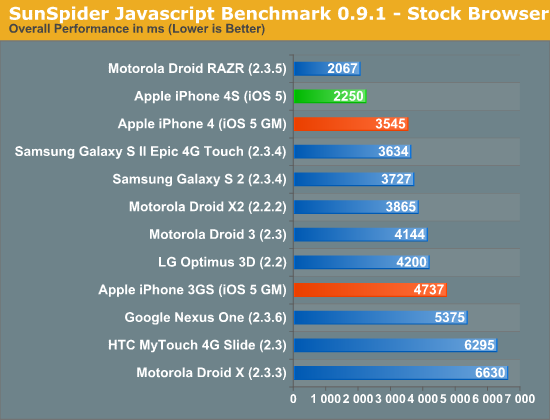
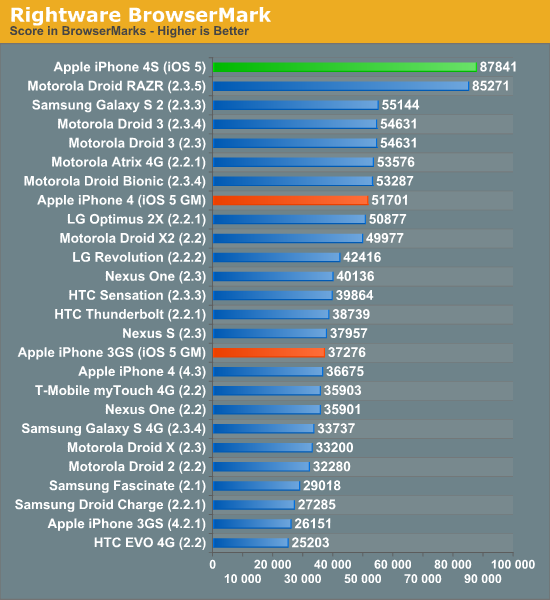
This translates directly into faster page load times. As you can see in the video below, the iPhone 4S (left) loads the AnandTech front page over WiFi in about 5 seconds compared to 9 seconds on the iPhone 4 (right). That's really the best case scenario, the improvement in the next page load time was only about a second (7s vs 8s).
Typical improvements in load time fall in the 10 - 70% range, contributing significantly to the phone feeling snappier than its predecessor. To quantify the improvement I ran through our standard web page loading suite, a test that hits AnandTech, CNN, NYTimes, Engadget, Amazon, Digg and Reddit hosted locally on our lab's network. The average page load time over WiFi for all of the pages is below:
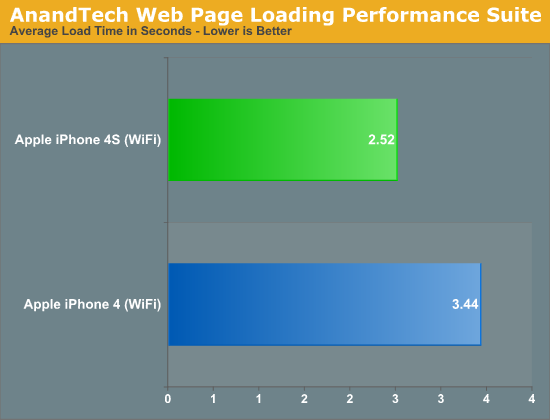
While web page rendering is a natural fit for multiple cores, I was surprised by how poorly threaded some apps ended up being. For example, although I did see performance improvements in exporting edited videos from the iOS version of iMovie, the gains weren't always evident. A quick profile of the app revealed that much of the export process is still single threaded. Just as we've seen on the desktop, there will be some added work necessary to get all apps to utilize multiple cores on iOS.
It's not always performance within an app that saw improvement with the A5: application install and launch times are also much quicker on the 4S. The time to launch Epic's iOS Citadel demo went from 32 seconds on the iPhone 4 to 22 seconds on the 4S. While the iPhone 4 may feel fast enough for many users, the 4S is noticeably faster.
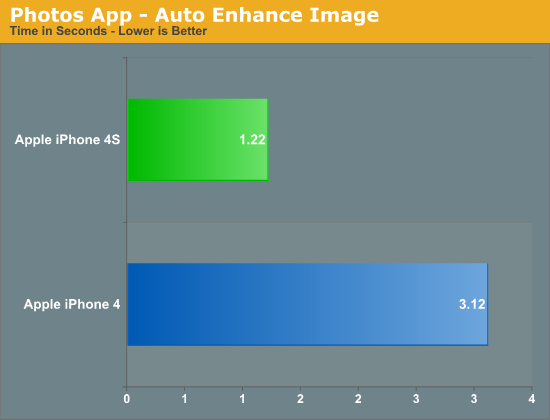
Much of the faster feel comes from by shaving off of seconds here or there. For example, I noticed apps like Messages pop up just slightly quicker on the 4S and you'll see your listing of messages a hair faster than you would on the 4. In the video above you get a brief idea of the sort of subtle improvements I'm talking about. YouTube launches a fraction of a second quicker on the 4S vs the 4.
These subtle decreases in response time are simply icing on the cake. The move from a 4 to a 4S is one of those upgrades that you'll notice right off the bat but will really appreciate if you go back to an iPhone 4 and try to use it. If you do a lot of web browsing on your phone, you'll appreciate the 4S.
I wasn't entirely sure whether or not I could attribute all of these performance improvements to the faster CPU. It's possible that some of the tests I mentioned are IO bound and Apple could have used faster NAND in the 4S. To find out I rounded up a bunch of iPhone 4Ses at all available capacities and measured sequential write speed:
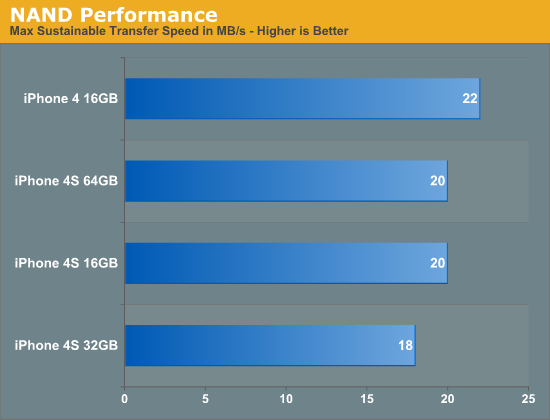
Apple uses multiple sources for NAND so it's possible that you'll see these numbers move around a bit depending on your particular phone. It looks like the iPhone 4S' NAND is no faster than what Apple shipped last year - at least in sequential write speed. The target appears to be 20MB/s and Apple does its best to stay around there. My iPhone 4 is actually pretty quick at 22MB/s but the advantage isn't significant enough to make a huge deal about. I don't have a good way of measuring random IO performance yet but application launch time is largely governed by sequential IO so I don't expect we're seeing gains from anything outside of the CPU and memory bandwidth in the earlier tests.


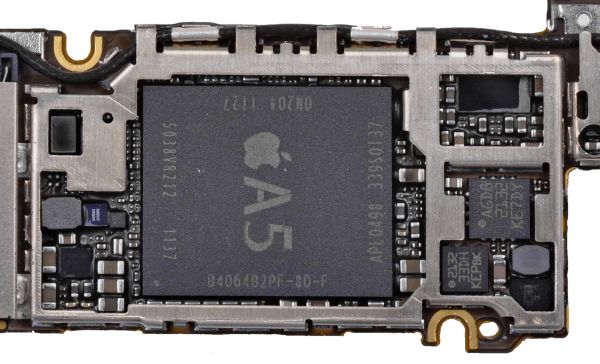








199 Comments
View All Comments
doobydoo - Friday, December 2, 2011 - link
You don't have to be concerned with something to care about getting an improved version.For example, I may be quite happy to work for a salary of £1,000,000 a year, but that doesn't mean I wouldn't care if my salary was doubled.
Grandpa - Wednesday, November 9, 2011 - link
Anyone heard of staticgate yet? How come nobody gives a review about the static issue on the iphone?mymomentummedia - Thursday, November 10, 2011 - link
Here is a funny iphone 4s review... iphone 4s plus a 50.cal Barret sniper rifle. what do you get?http://www.youtube.com/watch?v=RsVEbRt6g94
chillstatus - Monday, November 14, 2011 - link
I made sure to switch my dataplan over to the "Unlimited Data Plan for iPhone 4S" and when I run the field test, it still says it's using wap.cingular. I live in Los Angeles, and am wondering how I can get it to use the faster network. Anyone else have this issue?rhch - Sunday, February 5, 2012 - link
I just found out that my 4S wifi range is not as good as my old iPhone 4 or iPad 2.4S gets much earlier "no connection" with Safari, Appstore etc when i take distance to my hotspot.
Can someone confirm this?
AlexD - Monday, February 6, 2012 - link
With this commend I ask for help to find a developer for an iPhone-App that enables to use the 4S for the catching of light below 380nm (UV) and above 780 nm (NIR). The purpose is to identify light emission of materials (inks, plastics) outside the visible range and to visualize it with the smartphone. Even a slight range (e.g. >320nm or <850nm would help me.I would also be very greatful if somebody could explain what range of wavelength the 4S camera sensor is catching, if there are filters which can be removed or exchanged or the like to enable the above function. Thanks in advance for your support.
meace - Sunday, February 12, 2012 - link
Is the POP memory attachment to the A4 permanent?As in... could that pop ddr sdram of 128 *2 be replaced with 256 *2 ?
I'm guessing there's no way that it's coming apart without damage
(maybe even in a clean room) but I'll ask.
vitaprimo - Saturday, August 18, 2012 - link
I don't think it's the phone's fault that much. I have two iPhone 4s (not 4Ss) on different carriers (Telcel and Iusacell) and the never lose signal, no matter how tightly I grip them and I don't use cases. Now, one of the carrier is relatively new in my state and out of the major cities I've had a few dropped calls but they always connect back. I use to have iPhone 4Ss and I noticed no difference; I lost a bag with the phones in it so I'm using my old 4s until the sixth comes out--hopefully in less than two months.This whole antenna issue seems to just be affecting carriers in the US--that being AT&T.
phero - Friday, January 18, 2013 - link
Thank you very much for this extensive review, especially the part about power consumption. It has given me all the information I needed for a well informed decision on which phone to buy.